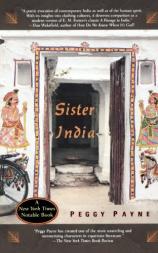Reading Group Guide
Discussion Questions
Sister India

1. When the twenty year-old Estelle flees her American life to live in India, she selects a new Hindi name for herself: Natraja. What does this choice say about the way she sees herself and her future? Does having this name influence the course of the life she makes for herself? Can you think of a counterpart in Judeo-Christian culture to what the name Natraja signifies to a Hindu?
2. What part does the river Ganges play in the transformations of the people in the guest house? How is the effect different for each character? How do other religions make use of water as a symbol or a sacred entity?
3. What physical elements of the city of Varanasi make the spiritual transformations in this story possible? Are any of these seemingly negative or frightening, perhaps dangerous? Does the nature of the physical environment in the story seem to shift in any way as the novel progresses? How so?
4. Do you think Natraja would have changed if the terrorist violence had not broken out around her? What similarities do you see between the psychological effects of terrorism in the story and those in the real world?
5. Do Ramesh's feelings for Natraja evolve during the course of the story? What drives him? What are his passions? Is he a happy man?
6. Did the young Natraja's love affair with the princely Bhushan turn out as it should have? Do you think their romance was based mainly on the temptation of forbidden fruit? Or were they true soul mates, kept apart only by their cultural differences?
7. How are Hindu rituals and images pivotal in the characters' lives? By what method do these outward signs of Hindu belief lead to inner change?
8. What are the stages in Natraja's emotional decline? What triggers the changes in her state of mind and how do these show themselves to people around her? How does Natraja inadvertently alter the emotional lives of the other characters?
9. What makes a city or a place holy? Is a pilgrimage site essentially different from other places? How?
10. This story takes place in India with flashbacks to the American rural South. Do you sense some kinship between these two very different parts of the world? What would you identify as the source of any similarities between the two regions?
11. Do you think there's a way to end the cycle of retaliation in this story, or will both groups attack each other until one or both fall from exhaustion and depletion?
12. What part does love, romantic or otherwise, play in the outcome of this story? If Dr. Rai were to vanish, could T.J. and Mrs. Rai live together happily ever after? How do you think the tie between Natraja and Ramesh will evolve? Will Jill and Marie ultimately find happiness in a romantic partnership?
13. Jill appears at times to be tightly wound and at other times to be crazy. Does her obsessive-compulsiveness have a solution? Do you believe she would seek help, or content herself with an emotionally constricted life?
14. What might Marie realistically accomplish in the years she has left? Do you think she has made a good choice at the story's end? What might her children have to say about her decision to stay? What would be the wisest stance for them to take toward their elderly mother's behavior?
15. What is the place of hunger in this story? Will Natraja remain obese? What do each of the characters hunger for? Must a profound longing be satisfied for a person to lead a happy life?
16. Why do you think the novel is called Sister India? Is there more than one way to understand the title? Does it fit the book?
Sister India
- Publication Date: February 5, 2002
- Genres: Fiction
- Paperback: 320 pages
- Publisher: Riverhead Trade
- ISBN-10: 1573229105
- ISBN-13: 9781573229104






